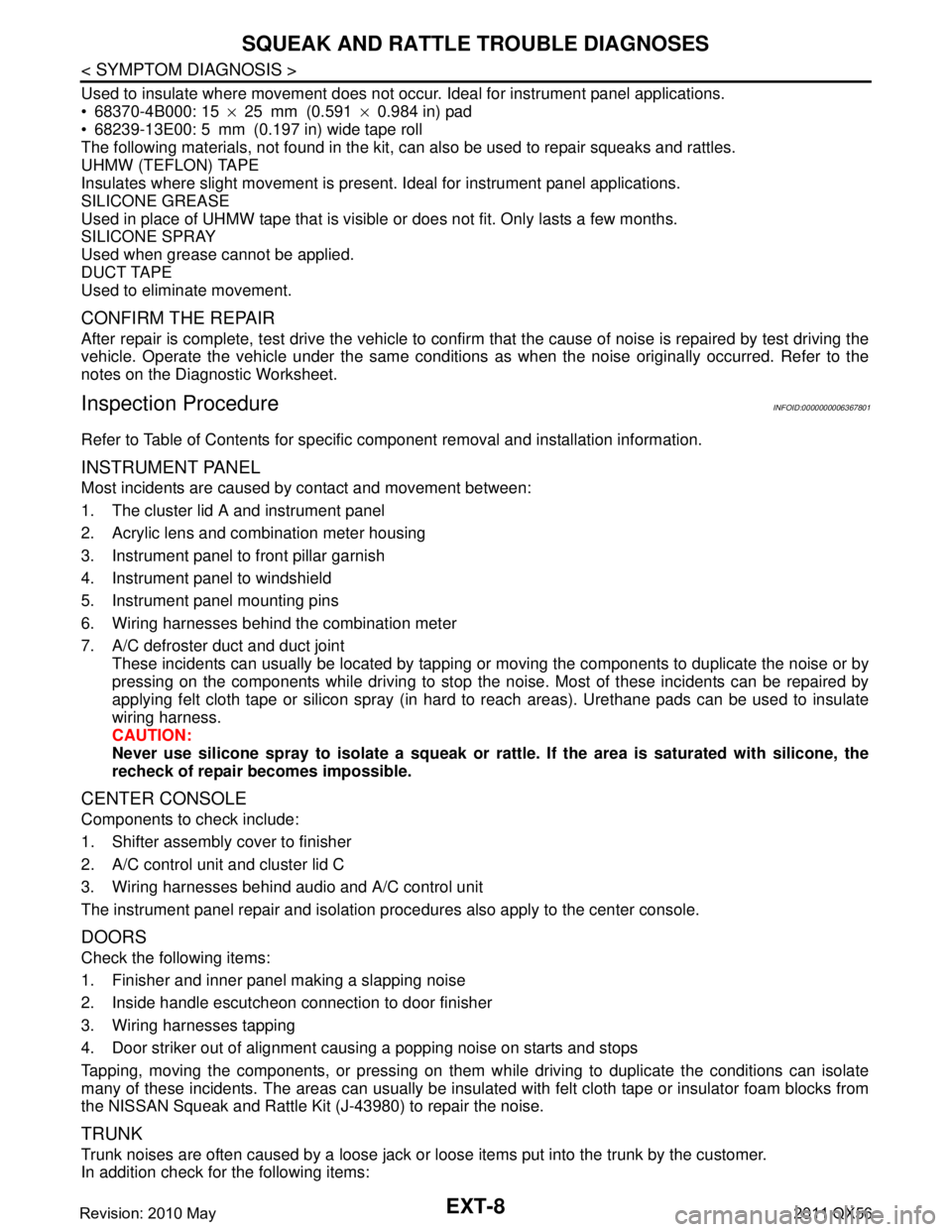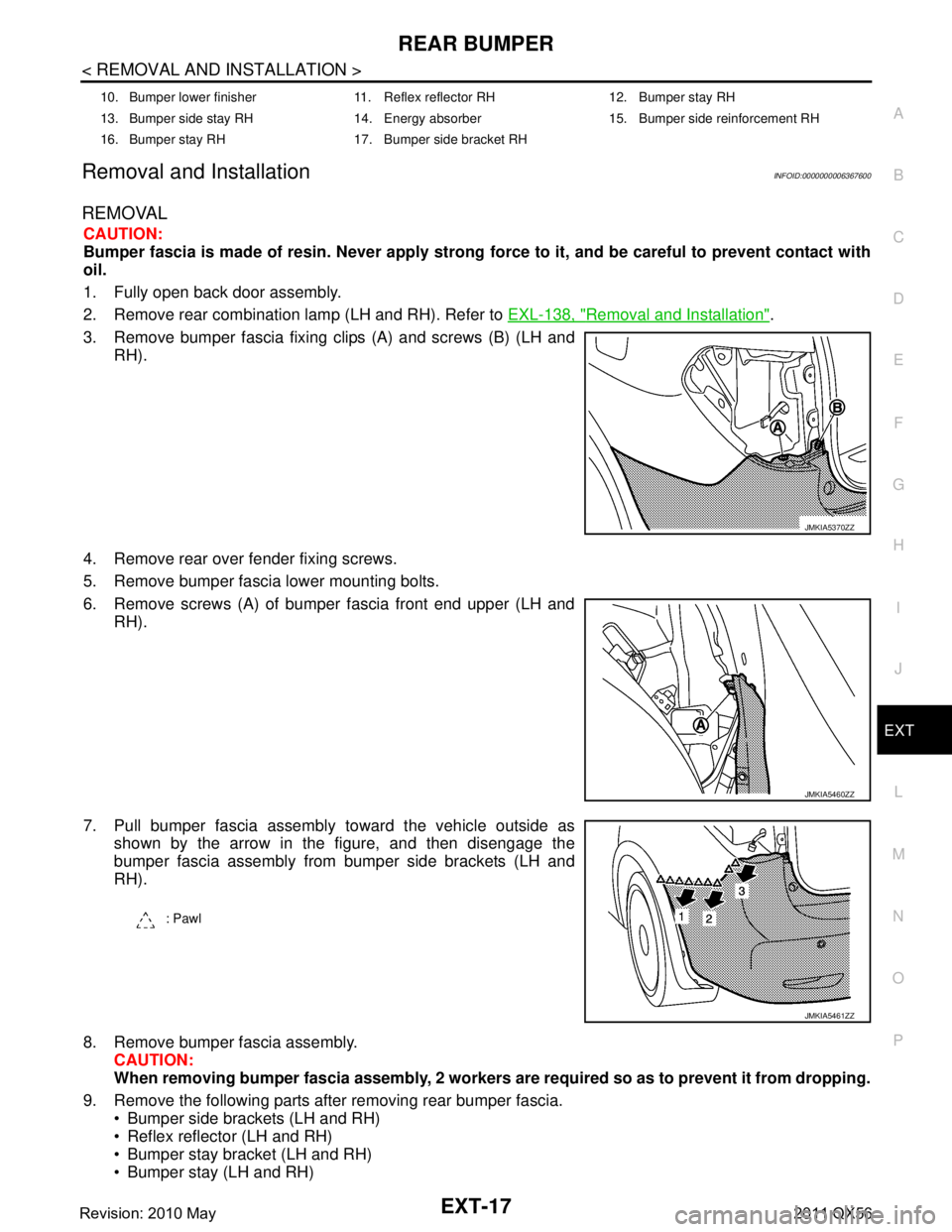Page 2863 of 5598

EXT-8
< SYMPTOM DIAGNOSIS >
SQUEAK AND RATTLE TROUBLE DIAGNOSES
Used to insulate where movement does not occur. Ideal for instrument panel applications.
68370-4B000: 15 ×25 mm (0.591 ×0.984 in) pad
68239-13E00: 5 mm (0.197 in) wide tape roll
The following materials, not found in the kit, can also be used to repair squeaks and rattles.
UHMW (TEFLON) TAPE
Insulates where slight movement is present. Ideal for instrument panel applications.
SILICONE GREASE
Used in place of UHMW tape that is visible or does not fit. Only lasts a few months.
SILICONE SPRAY
Used when grease cannot be applied.
DUCT TAPE
Used to eliminate movement.
CONFIRM THE REPAIR
After repair is complete, test drive the vehicle to confir m that the cause of noise is repaired by test driving the
vehicle. Operate the vehicle under the same conditions as when the noise originally occurred. Refer to the
notes on the Diagnostic Worksheet.
Inspection ProcedureINFOID:0000000006367801
Refer to Table of Contents for specific component removal and installation information.
INSTRUMENT PANEL
Most incidents are caused by contact and movement between:
1. The cluster lid A and instrument panel
2. Acrylic lens and combination meter housing
3. Instrument panel to front pillar garnish
4. Instrument panel to windshield
5. Instrument panel mounting pins
6. Wiring harnesses behind the combination meter
7. A/C defroster duct and duct joint
These incidents can usually be located by tapping or moving the components to duplicate the noise or by
pressing on the components while driving to stop the noise. Most of these incidents can be repaired by
applying felt cloth tape or silicon spray (in hard to reach areas). Urethane pads can be used to insulate
wiring harness.
CAUTION:
Never use silicone spray to isolate a squeak or ra ttle. If the area is saturated with silicone, the
recheck of repair becomes impossible.
CENTER CONSOLE
Components to check include:
1. Shifter assembly cover to finisher
2. A/C control unit and cluster lid C
3. Wiring harnesses behind audio and A/C control unit
The instrument panel repair and isolation pr ocedures also apply to the center console.
DOORS
Check the following items:
1. Finisher and inner panel making a slapping noise
2. Inside handle escutcheon connection to door finisher
3. Wiring harnesses tapping
4. Door striker out of alignment causing a popping noise on starts and stops
Tapping, moving the components, or pressing on them wh ile driving to duplicate the conditions can isolate
many of these incidents. The areas can usually be insula ted with felt cloth tape or insulator foam blocks from
the NISSAN Squeak and Rattle Kit (J-43980) to repair the noise.
TRUNK
Trunk noises are often caused by a loose jack or loose items put into the trunk by the customer.
In addition check for the following items:
Revision: 2010 May2011 QX56
Page 2872 of 5598

REAR BUMPEREXT-17
< REMOVAL AND INSTALLATION >
C
DE
F
G H
I
J
L
M A
B
EXT
N
O P
Removal and InstallationINFOID:0000000006367600
REMOVAL
CAUTION:
Bumper fascia is made of resin. Never apply strong force to it, and be careful to prevent contact with
oil.
1. Fully open back door assembly.
2. Remove rear combination lamp (LH and RH). Refer to EXL-138, "
Removal and Installation".
3. Remove bumper fascia fixing clips (A) and screws (B) (LH and RH).
4. Remove rear over fender fixing screws.
5. Remove bumper fascia lower mounting bolts.
6. Remove screws (A) of bumper fascia front end upper (LH and RH).
7. Pull bumper fascia assembly toward the vehicle outside as shown by the arrow in the figure, and then disengage the
bumper fascia assembly from bumper side brackets (LH and
RH).
8. Remove bumper fascia assembly. CAUTION:
When removing bumper fascia assembly, 2 workers ar e required so as to prevent it from dropping.
9. Remove the following parts after removing rear bumper fascia. Bumper side brackets (LH and RH)
Reflex reflector (LH and RH)
Bumper stay bracket (LH and RH)
Bumper stay (LH and RH)
10. Bumper lower finisher 11. Reflex reflector RH 12. Bumper stay RH
13. Bumper side stay RH 14. Energy absorber 15. Bumper side reinforcement RH
16. Bumper stay RH 17. Bumper side bracket RH
JMKIA5370ZZ
JMKIA5460ZZ
: Pawl
JMKIA5461ZZ
Revision: 2010 May2011 QX56
Page 2873 of 5598
EXT-18
< REMOVAL AND INSTALLATION >
REAR BUMPER
Bumper protector (LH and RH)
Bumper side reinforcement (LH and RH)
10. Remove energy absorber.
INSTALLATION
Note the following item, and then install in the reverse order of removal.
NOTE:
The following table shows the specified values for checking normal installation status.
Fitting adjustment cannot be performed.
JMKIA5455ZZ
Portion Clearance Surface height difference
Bumper fascia assembly –
Rear fender A – A0.0 – 1.0 mm
(0.000 – 0.039 in) (-0.7) – (+1.3) mm
[(-0.028) – (+0.051) in]
Bumper fascia assembly –
Rear combination lamp B – B0.3 – 3.0 mm
(0.012 – 0.118 in) —
Bumper fascia assembly –
Back door C – C2.8 – 6.1 mm
(0.110 – 0.240 in) —
Bumper fascia assembly –
Back door D – D3.8 – 7.8 mm
(0.150 – 0.307 in) —
Revision: 2010 May2011 QX56
Page 2887 of 5598
EXT-32
< REMOVAL AND INSTALLATION >
DOOR OUTSIDE MOLDING
DOOR OUTSIDE MOLDING
Exploded ViewINFOID:0000000006367617
Removal and InstallationINFOID:0000000006367618
FRONT DOOR OUTSIDE MOLDING
Removal
1. Fully open door window.
1. Front door panel 2. Front door outside molding 3. Rear door outside molding
4. Rear door panel: Pawl
JMKIA5372ZZ
Revision: 2010 May2011 QX56
Page 2888 of 5598
DOOR OUTSIDE MOLDINGEXT-33
< REMOVAL AND INSTALLATION >
C
DE
F
G H
I
J
L
M A
B
EXT
N
O P
2. Twist and pull up to upper side, and then remove front door out- side molding (1).
CAUTION:
Apply protective tape around front door panel.
Never twist and pull up to do or outside molding strongly.
REAR DOOR OUTSIDE MOLDING
1. Fully open door window.
2. Twist and pull up to upper side, and then remove rear door out-
side molding (1).
CAUTION:
Apply protective tape around rear door panel.
Never twist and pull up to do or outside molding strongly.
Installation
Install in the reverse order of removal.
JMKIA2024ZZ
JMKIA2026ZZ
Revision: 2010 May2011 QX56
Page 2889 of 5598
EXT-34
< REMOVAL AND INSTALLATION >
DOOR PARTING SEAL
DOOR PARTING SEAL
Exploded ViewINFOID:0000000006367619
Removal and InstallationINFOID:0000000006367620
REMOVAL
1. Fully open door.
2. Disengage the door parting seal fixing clips with a remover tool, and then remove door parting seal.CAUTION:
Disengage the clips slowly and carefully.
Never pull the door parting seal strongly.
INSTALLATION
Note the following items, and then install in the reverse order of removal.
CAUTION:
1. Front door parting seal 2. Rear door parting seal 3. Double sided tape
[0.8 mm (0.031) in]
: Vehicle front
Refer to GI-4, "
Components" for symbols in the figure.
JMKIA5379ZZ
Revision: 2010 May2011 QX56
Page 2890 of 5598
DOOR PARTING SEALEXT-35
< REMOVAL AND INSTALLATION >
C
DE
F
G H
I
J
L
M A
B
EXT
N
O P
When installing, check visually th e clips, then replace them with new parts if they have been dam-
aged.
When installing door parting seal, check that blin d clips are securely fitted in panel holes on body,
and then press them in.
Always replace double-sided tape with a new one, if door parting seal.
Revision: 2010 May2011 QX56
Page 2891 of 5598
EXT-36
< REMOVAL AND INSTALLATION >
SILL MOLDING
SILL MOLDING
Exploded ViewINFOID:0000000006367621
Removal and InstallationINFOID:0000000006367622
REMOVAL
1. Fully open front and rear door.
2. Disengage sill molding (1) fixing clips with a remover tool (A),and then remove sill molding.
CAUTION:
Disengage the clips slowly and carefully.
Never pull the sill molding strongly.
INSTALLATION
Note the following items, and then install in the reverse order of removal.
CAUTION:
When installing, check visually th e sill molding and the clips, then replace them with new parts if
they have been damaged.
When installing the sill molding, check that blind clips are secure ly fitted in panel holes on body, and
then press them in.
1. Sill molding 2. Double-sided tape
[t: 1.2 mm (0.047) in]
Refer to GI-4, "
Components" for symbols in the figure.
JMKIA5380ZZ
: Clip
JMKIA2029ZZ
Revision: 2010 May2011 QX56